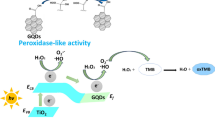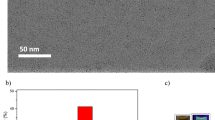Abstract
This work describes the synthesis, characterization, and application of a new ternary rGO-AuNPs-Cdots nanocomposite, which was extensively characterized by high-resolution electron microscopy (HR-TEM), UV-Vis spectroscopy, Raman spectroscopy, atomic force microscopy (AFM), X-ray diffraction (XRD), and electrochemical techniques. The nanocomposite was used to modify the surface of the glassy carbon electrode aiming to develop an electrochemical sensor for simultaneous determination of phenolic isomers. Electrochemical studies were performed in acetate buffer, pH 5.5. The modified rGO-AuNPs-Cdots electrode showed good electrocatalytic response for simultaneous determination of hydroquinone and catechol in the presence of resorcinol with detection limit of 1.2 × 10−8 mol L−1 and 9.6 × 10−8 mol L−1, respectively. This electrode also showed good electrocatalytic response for simultaneous determination of hydroquinone and catechol in real samples in the presence of other interferents.

Graphical abstract









Similar content being viewed by others
References
Baker SN, Baker GA (2010) Luminescent carbon nanodots: emergent nanolights. Angew Chem Int Ed 49:6726–6744
Blaut M, Braune A, Wunderlich S, Sauer P, Schneider H, Glatt H (2006) Mutagenicity of arbutin in mammalian cells after activation by human intestinal bacteria. Food Chem Toxicol 44:1940–1947
Canevari TC, Arenas LT, Landers R, Custodio R, Gushikem Y (2013) Simultaneous electroanalytical determination of hydroquinone and catechol in the presence of resorcinol at an SiO2/C electrode spin-coated with a thin film of Nb2O5. Analyst 138:315–324
Canevari TC, Nakamura M, Cincotto FH, de Melo FM, Toma HE (2016) High performance electrochemical sensors for dopamine and epinephrine using nanocrystalline carbon quantum dots obtained under controlled chronoamperometric conditions, Electrochim. Acta 209:464–470
Chapman CT, Liang W, Li X (2011) Ultrafast coherent electron–hole separation dynamics in a fullerene derivative. J Phys Chem Lett 2:1189–1192
Chen Y, Liu X, Zhang S, Yang L, Liu M, Zhang Y, Yao S (2017) Ultrasensitive and simultaneous detection of hydroquinone, catechol and resorcinol based on the electrochemical co-reduction prepared Au-Pd nanoflower/reduced graphene oxide nanocomposite. Electrochim Acta 231:677–685
Dimiev AM, Tour JM (2014) Mechanism of graphene oxide formation. ACS Nano 8:3060–3068
Ding H, Yu SB, Wei JS, Xiong HM (2016) Full-color light-emitting carbon dots with a surface-state-controlled luminescence mechanism. ACS Nano 10:484–490
Emam AN, Loutfy SA, Mostafa AA, Awad H, Mohamed MB (2017) Cyto-toxicity, biocompatibility and cellular response of carbon dots–plasmonic based nano-hybrids for bioimaging. RSC Adv 7:23502–23514
Fan Z, Wang K, Wei T, Yan J, Song L, Shaodue B (2010) An environmentally friendly and efficient route for the reduction of graphene oxide by aluminum powder. Carbon 48:1686–1689
Gomez-Navarro C, Meyer JC, Sundaram RS, Chuvilin A, Kurasch S, Burghard M, Kern K, Kaiser U (2010) Atomic structure of reduced graphene oxide. Nano Lett 10:1144–1148
Guo HL, Wang XF, Qian QY, Wang FB, Xia X-H (2009) A green approach to the synthesis of graphene nanosheets. ACS Nano 39:2653–2659
Hontoria-Lucas C, Lopez-Einado AJ, Lopez-Gonzalez JDD, Rojas-Cervantes ML, Martin-Aranda RM (1995) Study of oxygen-containing groups in a series of graphite oxides: physical and chemical characterization. Carbon 33:1585–1592
Kong FY, Li RF, Yao L, Wang ZX, Li HY, Lv WX, Wang W (2019) Voltammetric simultaneous determination of catechol and hydroquinone using a glassy carbon electrode modified with a ternary hybrid material composed of reduced graphene oxide, magnetite nanoparticles and gold nanoparticles. Microchim Acta 186:177–182
Lara-Guzmán OJ, Álvarez-Quintero R, Osorio E, Naranjo-Cano M, Muñoz-Durango K (2016) GC/MS method to quantify bioavailable phenolic compounds and antioxidant capacity determination of plasma after acute coffee consumption in human volunteers. Food Res Int 89:219–226
Liu Y, Wang Q, Guo S, Jia P, Shui Y, Yao S, Huang C, Zhang M, Wang L (2018) Highly selective and sensitive fluorescence detection of hydroquinone using novel silicon quantum dots. Sensor Actuat B-Chem 275:415–421
Luo P, Li C, Shi G (2012) Synthesis of gold@carbon dots composite nanoparticles for surface enhanced Raman scattering. Phys Chem Chem Phys 14:7360–7366
Luo X, Zheng H, Zhang Z, Wang M, Yang B, Huang L, Wang M (2018) Cloud point extraction for simultaneous determination of 12 phenolic compounds by high performance liquid chromatography with fluorescence detection. Microchem J 137:148–154
Meng S, Hong Y, Dai Z, Huang W, Dong X (2017) Simultaneous detection of Dihydroxybenzene isomers with ZnO nanorod/carbon cloth electrodes. ACS Appl Mater Inter 9:12453–12460
Merkoçi A (2013) Nanoparticles based electroanalysis in diagnostics applications. Electroanalysis 25:15–27
Molina J, Cases F, Moretto LM (2016) Graphene-based materials for the electrochemical determination of hazardous ions. Anal Chim Acta 946:9–39
Nasr B, Abdellatif G, Canisares P, Saaez C, Lobato J, Rodrigo M (2005) Electrochemical oxidation of hydroquinone, resorcinol, and catechol on boron-doped diamond anodes. Environ Sci Technol 39:7234–7239
Nissanka B, Kottegoda N, Jayasundara DR (2020) Probing structural variations of graphene oxide and reduced graphene oxide using methylene blue adsorption method. J Mater Sci 55:1996–2005
Palanisamy S, Thangavelu K, Chen S-M, Thirumalraj B, Liu X-H (2016) Preparation and characterization of gold nanoparticles decorated on graphene oxide@polydopamine composite: application for sensitive and low potential detection of catechol. Sensor Actuat B-Chem 233:298–306
Parvathi VP, Parimaladevi R, Sathe V, Umadevi M (2019) Application of G-SERS for the efficient detection of toxic dye contaminants in textile effluents using gold/graphene oxide substrates. J Mol Liq 273:203–214
Pei S, Cheng HM (2012) The reduction of graphene oxide. Carbon 50:3210–3228
Sahu S, Behera B, Maiti TK, Mohapatra S (2012) Simple one-step synthesis of highly luminescent carbon dots from orange juice: application as excellent bio-imaging agents. ChemComm 48:8835–8837
Thivya P, Ramya WR (2019) Environmental pollutants simultaneous determination: DNA catalyst mediated polyaniline biocomposite nanostructures. Biocatal Agric Biotechnol 21:101352–101358
Wang Z, Dai Z (2015) Carbon nanomaterial-based electrochemical biosensors: an overview. Nanoscale 7:6420–6431
Wang H, Hu Q, Meng Y, Jin Z, Fang Z, Fu Q, Gao W, Xu L, Song Y, Lu F (2018a) Efficient detection of hazardous catechol and hydroquinone with MOF-rGO modified carbon paste electrode. J Hazard Mater 353:151–157
Wang H, Zhang S, Li S, Qu J (2018b) Simultaneous determination of hydroquinone and catechol using a glassy carbon electrode modified with Au@Pd loaded on reduced graphene oxide. Anal Methods 10:1331–1338
Xiao Q, Sarina S, Bo A, Jia J, Liu H, Arnold DP, Huang Y, Wu H, Zhu H (2014) Visible light-driven cross-coupling reactions at lower temperatures using a photocatalyst of palladium and gold alloy nanoparticles. ACS Catal 4:725–1734
Xiao T, Huang J, Wang D, Meng T, Yang X (2020) Au and Au-based nanomaterials: synthesis and recent progress in electrochemical sensor applications. Talanta 206:120210–120229
Yang Z, Zheng X, Li Z, Zheng J (2016) A facile one-pot synthesis of carbon nitride dots–reduced graphene oxide nanocomposites for simultaneous enhanced detecting of dopamine and uric acid. Analyst 141:4757–4765
Yang W, Liang H, Ma S, Wang D, Huang J (2019) Gold nanoparticle based photothermal therapy: development and application for effective cancer treatment. SM&T 22:e00109–e00115
Yu D, Park K, Durstock M, Dai L (2011) Fullerene-grafted Graphene for efficient bulk heterojunction polymer photovoltaic devices. J Phys Chem Lett 2:1113–1118
Zhang XY, Li HP, Cui XL, Lin Y (2010) Graphene/TiO2 nanocomposites: synthesis, characterization and application in hydrogen evolution from water photocatalytic splitting. J Mater Chem 20:2801–2806
Acknowledgments
RC and T.C.C acknowledges Mackpesquisa.
Author information
Authors and Affiliations
Corresponding author
Ethics declarations
This study was funded by Mackpesquisa (grant number 0000680/005).
Conflict of interest
The authors declare that they have no conflict of interest.
Additional information
Publisher’s note
Springer Nature remains neutral with regard to jurisdictional claims in published maps and institutional affiliations.
Supplementary Information
ESM 1
(DOCX 115 kb)
Rights and permissions
About this article
Cite this article
Cesana, R., Gonçalves, J.M., Ignácio, R.M. et al. Synthesis and characterization of nanocomposite based on reduced graphene oxide-gold nanoparticles-carbon dots: electroanalytical determination of dihydroxybenzene isomers simultaneously. J Nanopart Res 22, 336 (2020). https://doi.org/10.1007/s11051-020-05059-3
Received:
Accepted:
Published:
DOI: https://doi.org/10.1007/s11051-020-05059-3




